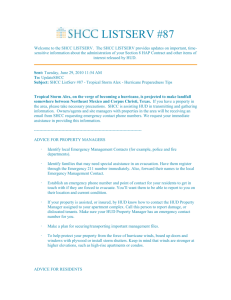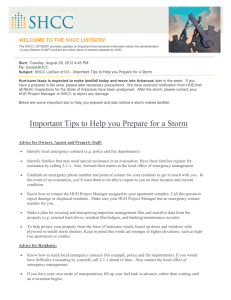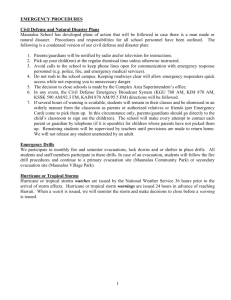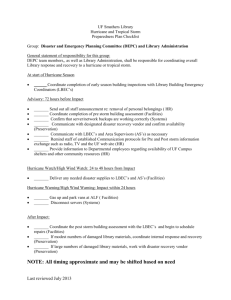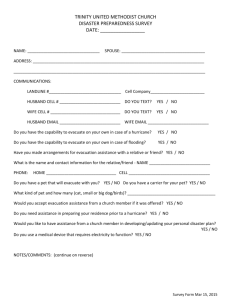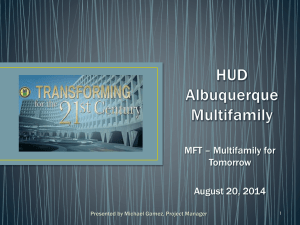Hurricane Preparedness
advertisement
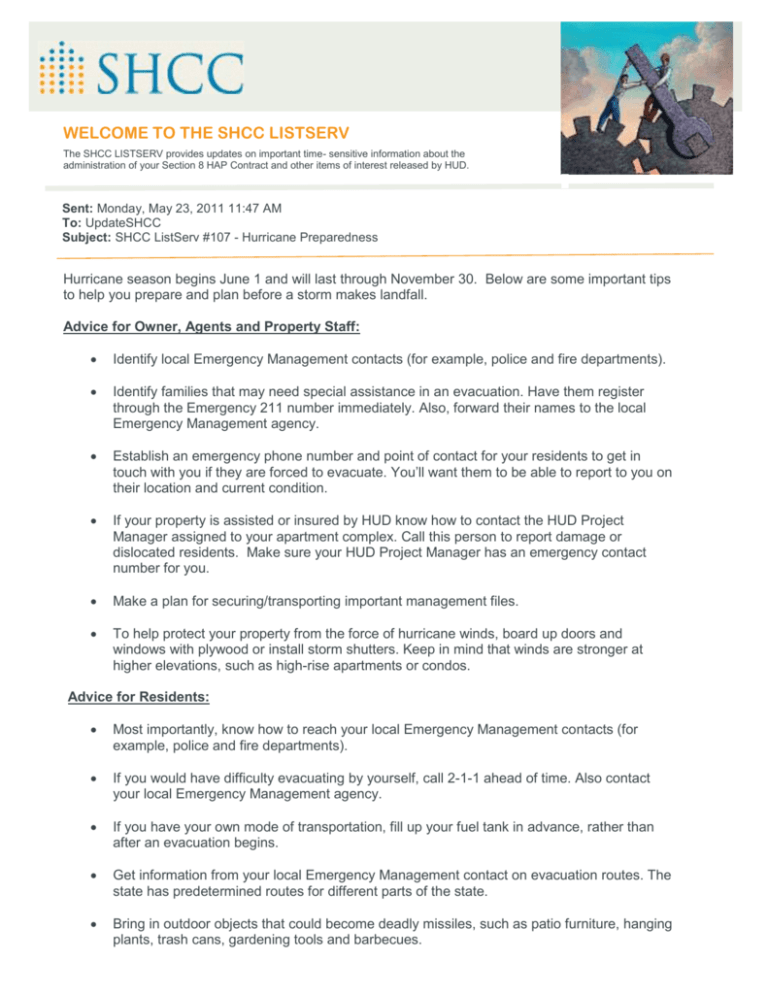
WELCOME TO THE SHCC LISTSERV The SHCC LISTSERV provides updates on important time- sensitive information about the administration of your Section 8 HAP Contract and other items of interest released by HUD. Sent: Monday, May 23, 2011 11:47 AM To: UpdateSHCC Subject: SHCC ListServ #107 - Hurricane Preparedness Hurricane season begins June 1 and will last through November 30. Below are some important tips to help you prepare and plan before a storm makes landfall. Advice for Owner, Agents and Property Staff: Identify local Emergency Management contacts (for example, police and fire departments). Identify families that may need special assistance in an evacuation. Have them register through the Emergency 211 number immediately. Also, forward their names to the local Emergency Management agency. Establish an emergency phone number and point of contact for your residents to get in touch with you if they are forced to evacuate. You’ll want them to be able to report to you on their location and current condition. If your property is assisted or insured by HUD know how to contact the HUD Project Manager assigned to your apartment complex. Call this person to report damage or dislocated residents. Make sure your HUD Project Manager has an emergency contact number for you. Make a plan for securing/transporting important management files. To help protect your property from the force of hurricane winds, board up doors and windows with plywood or install storm shutters. Keep in mind that winds are stronger at higher elevations, such as high-rise apartments or condos. Advice for Residents: Most importantly, know how to reach your local Emergency Management contacts (for example, police and fire departments). If you would have difficulty evacuating by yourself, call 2-1-1 ahead of time. Also contact your local Emergency Management agency. If you have your own mode of transportation, fill up your fuel tank in advance, rather than after an evacuation begins. Get information from your local Emergency Management contact on evacuation routes. The state has predetermined routes for different parts of the state. Bring in outdoor objects that could become deadly missiles, such as patio furniture, hanging plants, trash cans, gardening tools and barbecues. If your home is vulnerable to rising water, move furniture and valuables to a higher level. If you have pets, purchase carrying containers for their transport. Before evacuating, cut off your electricity and turn off the gas. Downed electrical wires and broken gas pipes can be deadly and cause serious property damage. Make a final walkthrough inspection of your home before leaving. Assemble a family emergency supply kit and have it ready to go at a moment’s notice. It should contain the following items: radio and flashlight with extra batteries, extra eye glasses, medications and prescriptions, special products for babies and the elderly, bottled water, non-perishable food, clothes, bedding and important documents sealed in waterproof containers. When officials recommend evacuation, leave. Do not try to ride out a hurricane in a high-risk area. Seek shelter inland with family or friends, at a hotel, or at a designated shelter. Notify relatives and friends of your plans, and confirm hotel reservations. Find out where shelters are located along your route in case clogged roads prevent you from reaching your destination. The State and Red Cross has recommended certain items in a “survival kit” to take if you are being evacuated by the State. Go to: http://www.txdps.state.tx.us/dem/pages/weather_aware_hurricane.htm for those recommendations. The State and local government will start making Public Address Announcements regarding the Storm. Keep your families informed of any announcements that are being made. Additional Guidance & Resources: Disaster guidance links and resources are available by going to SHCC’s website (www.shccnet.org) and clicking on the “Disaster Preparedness” link. In December 2010 HUD released a new Chapter 38 to the HUD Handbook 4350.1, Multifamily Asset Management and Project Servicing. This new Chapter 38, titled Multifamily Emergency/Disaster Guidance, assembles disaster guidance issued in previous Notices and memoranda into one Handbook Chapter and applies to all HUD-insured and/or assisted properties affected by a Presidentially Declared Disaster, or when a Hub Director determines that an emergency exists. This Chapter includes procedures and requirements for both HUD staff and Owners for dealing with an emergency. Click here to view Chapter 38. As storms approach and/or disasters occur HUD encourages owners, agents, and/or site staff of multifamily properties to post vacancy numbers to the National Housing Locator website (click on the Housing Neighbors in Disaster tab and follow the instructions to register). This vacancy data will help FEMA officials locate suitable housing for victims of natural disasters.
